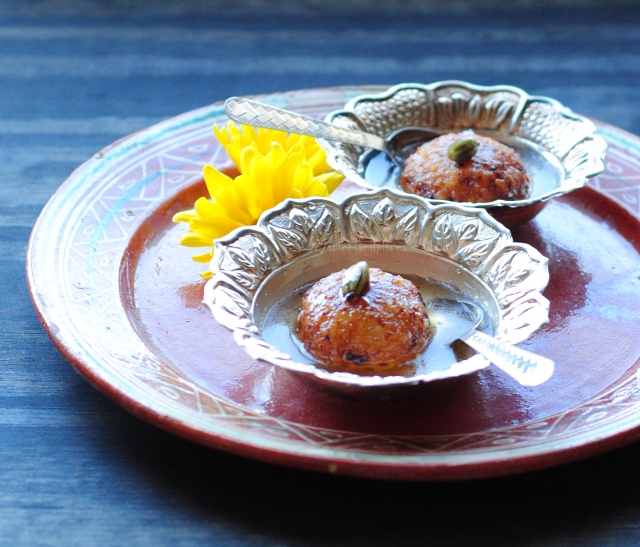I know I am way too late for Sankranti (last day of the Bengali month Poush and also a harvest festival) but we can never be too late for a delicious pithe (a type of Bengali dessert). Victim of some unknown inhibition, when I lived with my parents I learned only a small fraction of the many kinds of pithe my Maa makes. Many years later, now I am not afraid of cooking difficult things but pithe remains of those things which are on my to-do list but never materialized. I wish I had learnt them while I was in India, but then hindsight is always golden and I took everything for granted back in those days.
 Without going into too much detail, let’s go straight to the recipe. Truly speaking there is as such no detailed recipe. I saw the link for this recipe a long time ago and made it only once. When I wanted to recreate the recipe last week and tried to find the link again, I realized that the web page was gone. Alas! My memories are now as fleeting as they are digital, and I am a slave of silicon wafers and spinning disks that may hold recipes one second and pornography the next! But, I was determined to make pithe even though the only source I had was my memory which is not very reliable. I kind of used my best guess and the outcome has not been too bad. I am not claiming it’s as good as the ones my Maa made, but you know what? I like it… I like the simple and easy way of making it. I didn’t have the time and energy to grind rice and then make the traditional ones, but something is better than nothing. So, if you want to hold onto your traditions but don’t want to spend the entire day making puli-pithe or patishapta, this recipe can be your friend. Try it out next time you crave for something sweet. You don’t need an auspicious day to make it because it’s a modern-day pithe and doesn’t mind if Sankranti was yesterday.
Without going into too much detail, let’s go straight to the recipe. Truly speaking there is as such no detailed recipe. I saw the link for this recipe a long time ago and made it only once. When I wanted to recreate the recipe last week and tried to find the link again, I realized that the web page was gone. Alas! My memories are now as fleeting as they are digital, and I am a slave of silicon wafers and spinning disks that may hold recipes one second and pornography the next! But, I was determined to make pithe even though the only source I had was my memory which is not very reliable. I kind of used my best guess and the outcome has not been too bad. I am not claiming it’s as good as the ones my Maa made, but you know what? I like it… I like the simple and easy way of making it. I didn’t have the time and energy to grind rice and then make the traditional ones, but something is better than nothing. So, if you want to hold onto your traditions but don’t want to spend the entire day making puli-pithe or patishapta, this recipe can be your friend. Try it out next time you crave for something sweet. You don’t need an auspicious day to make it because it’s a modern-day pithe and doesn’t mind if Sankranti was yesterday.
Ingredients:
Cheera/flattened rice: 2 cups, Grated mewa/Khowa kheer/Milk solids: 2 cups+4 tbsp extra for filling, Sugar: 2 cups, Water: 2 cups, Cardamom: 2 pods, Freshly grated coconut: around 1/4 cup, Mewa: ¼ cup, Raisins: 12-14 nos., A pinch of salt, Oil for deep frying.
- Wash the flattened rice very briefly and then drain the water.
- Add the sugar to the water and bring the mixture to a boil in a deep heavy bottom pot. Break the cardamom pods a little bit and add them to the boiling syrup. Boil the mixture until it reduces to a medium-thick consistency. Do not make the syrup very thick; it won’t penetrate the rice balls.
- Add the grated mewa/khowa/milk solids to the soaked chire/flattened rice and a pinch of salt and mix very well. It should form dough like consistency. If the dough is crumbly or dry, add milk to it (the ratio of chire to mewa is 1:1).
- Shape them into lemon sized balls.
The filling:
- Mix around 3-4 tbsp mewa and 3-4 tbsp coconut together to prepare for the filling (If you want, you can cook the coconut and the mewa mixture on low flame, but it’s optional. I didn’t). I didn’t measure the filling amount, so it’s an approximation. You might need a little more or less of coconut or mewa.
- Put your thumb into the balls and create a small hole.
- Put a little bit of grated coconut-mewa mixture, one/two raisins and then close the hole.
- Press the ball with your palm and flatten the ball a little bit (optional).
Frying:
- Heat up the oil and deep fry the balls on medium high heat until golden brown in color. Be very careful, if the oil is too hot, they will burn from outside and remain uncooked from inside.
- Drain them on an absorbent paper.
- Drop them into the sugar syrup and simmer them for 10-15 minutes.
- Take the sugar syrup container out of the heat and let the balls soak in the syrup for several hours.
- Serve them chilled.

You can omit the filling part completely and it still tastes great. You can put only coconut/mewa/raisin as a filling. I had all of them and that’s the reason I put everything together.
I told you, it’s easy 🙂


